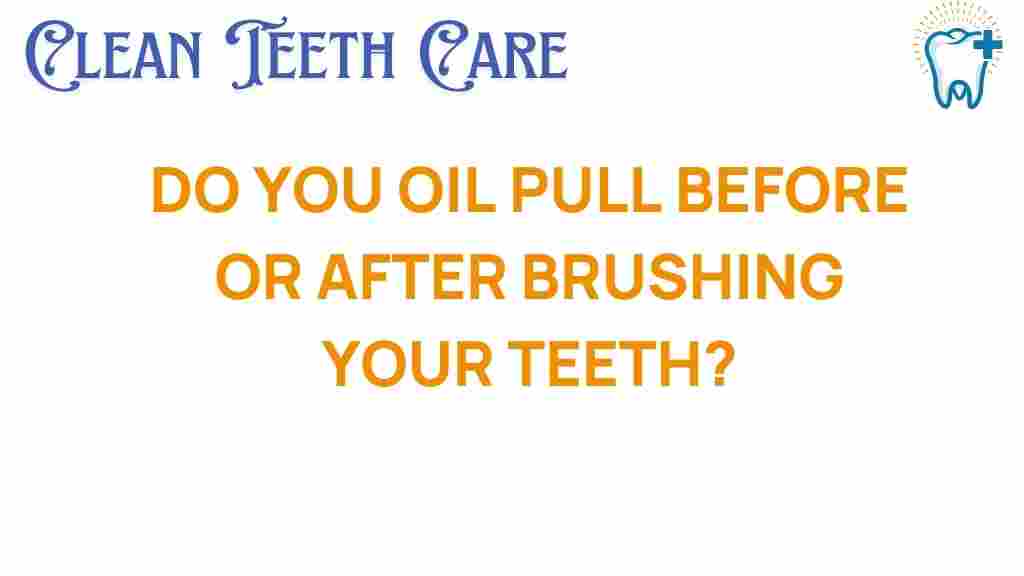The Great Debate: Should You Oil Pull Before or After Brushing?
In the realm of dental hygiene and oral care, oil pulling has emerged as a popular practice, touted for its myriad health benefits. This ancient Ayurvedic technique involves swishing oil in the mouth to improve gum health, whiten teeth, and remove toxins. However, a question that often arises is whether to oil pull before or after brushing your teeth. In this article, we will explore the techniques of oil pulling, its benefits, and how it fits into your overall dental hygiene routine.
Understanding Oil Pulling
Oil pulling is a natural remedy that involves swishing a tablespoon of oil, typically coconut, sesame, or sunflower oil, in your mouth for about 15-20 minutes. This practice is believed to draw out toxins and harmful bacteria, thereby promoting better oral health. The process is simple yet effective, and when combined with regular teeth brushing, it can significantly enhance your oral care routine.
The Benefits of Oil Pulling
Oil pulling offers numerous health benefits, which include:
- Improved Gum Health: Regular oil pulling can reduce inflammation and promote healthier gums.
- Whiter Teeth: Many users report a noticeable improvement in teeth whiteness.
- Reduced Plaque: Oil pulling can help reduce plaque buildup on teeth.
- Fresher Breath: It can also combat bad breath effectively.
- Toxin Removal: The practice is thought to help eliminate toxins from the body.
Incorporating oil pulling into your daily routine can enhance your preventive care strategy, ensuring optimal oral hygiene and health.
Oil Pulling: Before or After Brushing?
Now that we understand the benefits of oil pulling, let’s delve into the main question: should you oil pull before or after brushing your teeth? The answer is not straightforward, as both practices have their merits.
Oil Pulling Before Brushing
Many proponents of oil pulling recommend doing it before brushing your teeth. Here’s why:
- Maximized Bacteria Removal: Oil pulling first can help remove a significant amount of bacteria and plaque before you brush, allowing for better cleaning.
- Enhanced Fluoride Absorption: Brushing after oil pulling may help your toothpaste’s fluoride work more effectively.
- Better Freshness: Oil pulling before brushing can leave your mouth feeling fresher, helping to combat bad breath effectively.
Oil Pulling After Brushing
On the other hand, some people prefer to oil pull after brushing. Here are the benefits of this approach:
- Immediate Cleaning: Brushing first ensures that your teeth are clean, and oil pulling afterward can help rinse away any remaining bacteria.
- Enhanced Taste: For some, brushing first makes the oil pulling experience more pleasant by removing the strong taste of toothpaste.
- Post-Brushing Freshness: Oil pulling afterward can provide a final rinse for a fresh feeling.
Steps to Oil Pulling Effectively
Regardless of whether you choose to oil pull before or after brushing, following proper steps is essential for effectiveness:
- Choose Your Oil: Coconut oil is popular for its taste and antimicrobial properties, but sesame and sunflower oils are also effective.
- Measure the Oil: Take about one tablespoon of your chosen oil.
- Swish the Oil: Swish the oil in your mouth for 15-20 minutes. Avoid swallowing it, as it contains toxins and bacteria.
- Spit It Out: After the time is up, spit the oil into a trash can (not the sink, as it can clog pipes).
- Rinse Your Mouth: Rinse your mouth with warm water to remove any remaining oil.
- Brush Your Teeth: Finally, brush your teeth as usual to ensure a thorough clean.
Troubleshooting Common Oil Pulling Issues
While oil pulling can be a beneficial addition to your oral care routine, you may encounter some common issues. Here are some troubleshooting tips:
1. Oil Pulling is Unpleasant
If you find oil pulling uncomfortable:
- Start with a shorter duration (5-10 minutes) and gradually increase to 15-20 minutes.
- Try using a different oil, as some have a milder taste.
2. Difficulty Swishing
If swishing for 20 minutes feels challenging:
- Break it up into smaller sessions throughout the day.
- Practice swishing with a smaller amount of oil until you feel comfortable.
3. No Noticeable Results
For those not seeing results:
- Ensure you are consistent with your oil pulling routine.
- Combine oil pulling with regular dental hygiene practices, including brushing and flossing.
Conclusion
The debate on whether to oil pull before or after brushing ultimately depends on personal preference and comfort. Both methods have their benefits, and the key is to find a routine that works best for you. Whether you choose to integrate oil pulling as a pre-brushing ritual or as a post-brushing refresher, this natural remedy can play a valuable role in your dental hygiene and oral care regimen.
Incorporating oil pulling into your daily routine can help improve gum health, whiten your teeth, and contribute to overall oral wellness. As with any health practice, consistency is crucial to reaping the full health benefits of oil pulling. Remember, it is not a replacement for brushing and flossing, but rather a complementary practice that can enhance your preventive care efforts.
For more information on oral health and natural remedies, check out this comprehensive guide. You can also explore additional resources on dental hygiene and techniques to maintain a radiant smile.
This article is in the category Hygiene and created by CleanTeethCare Team
